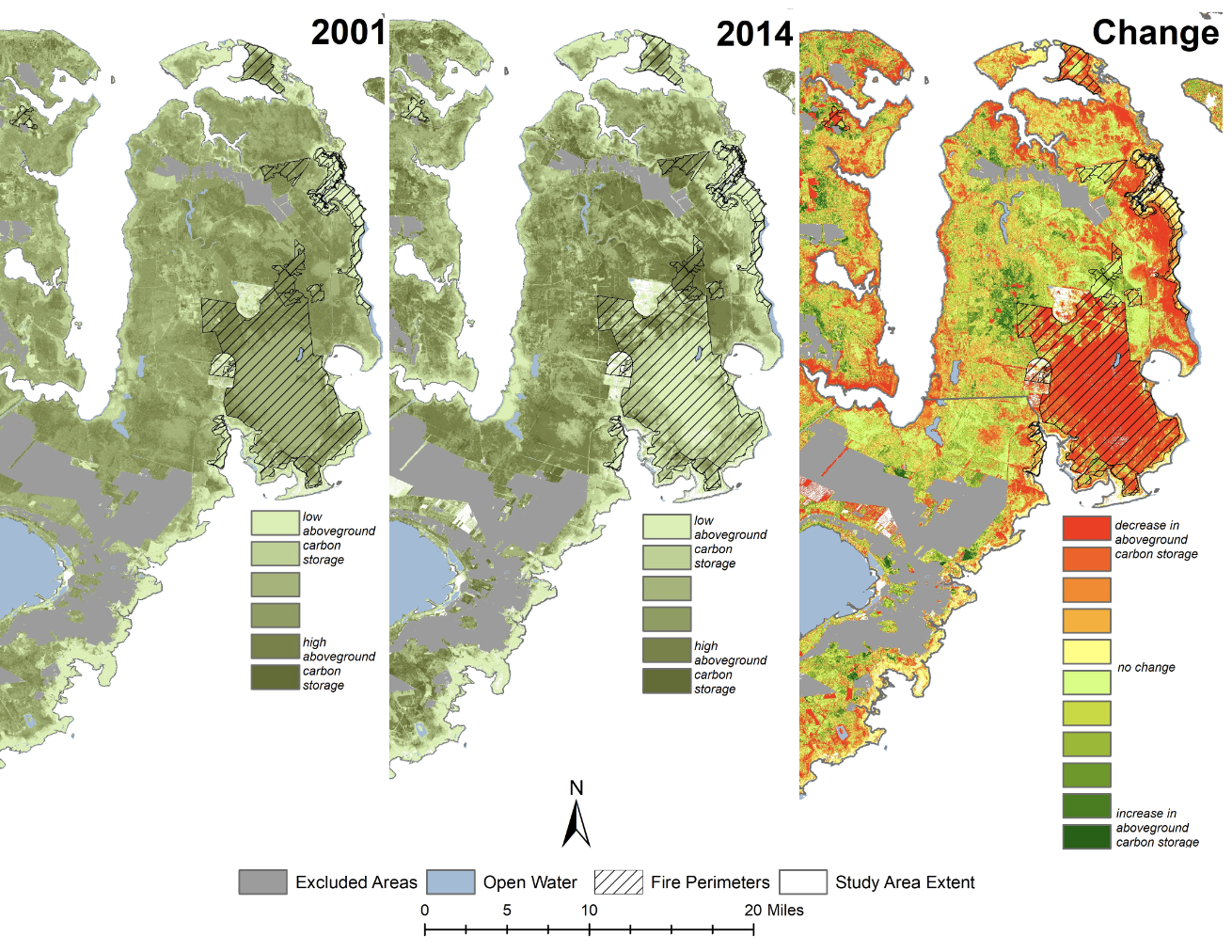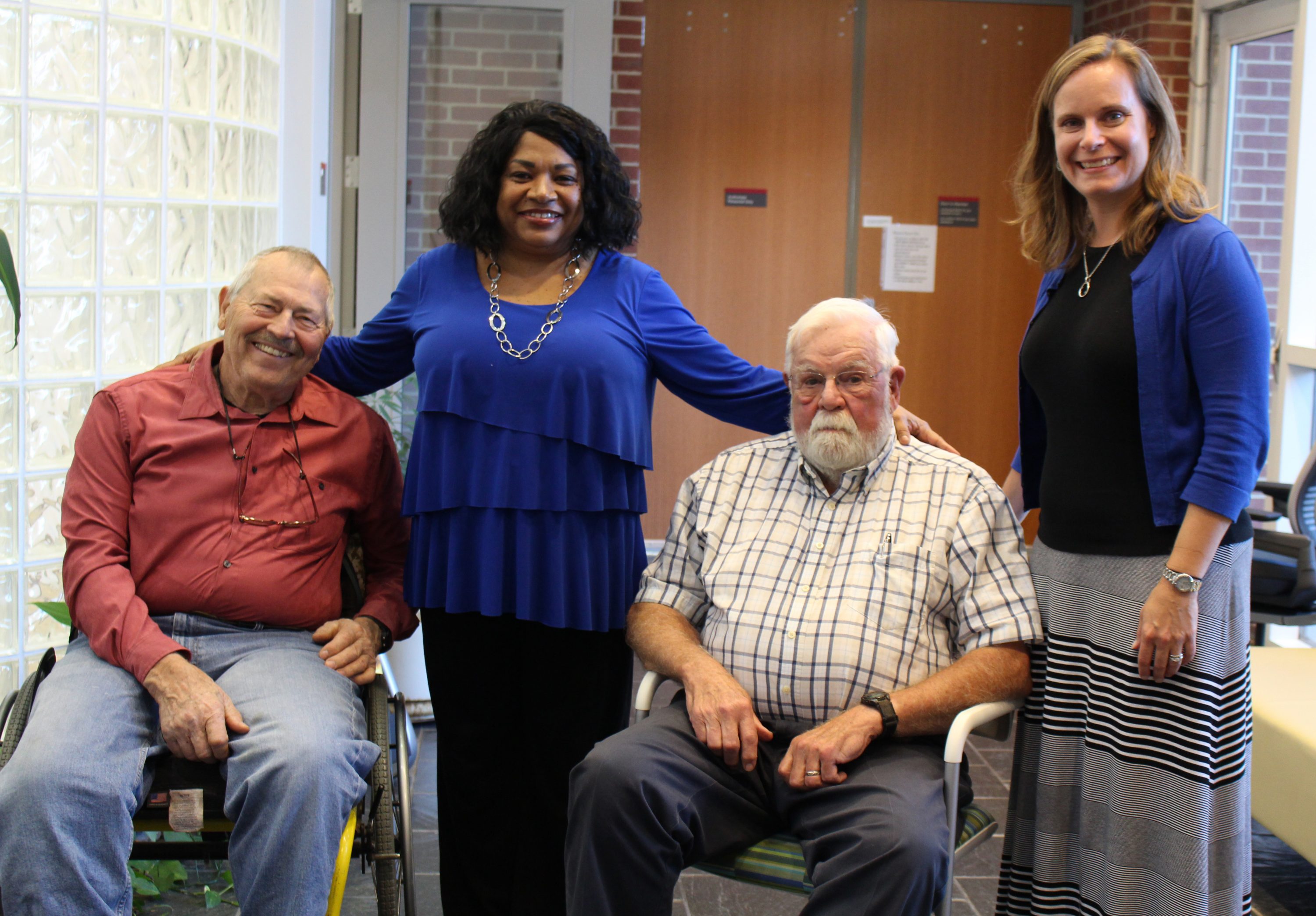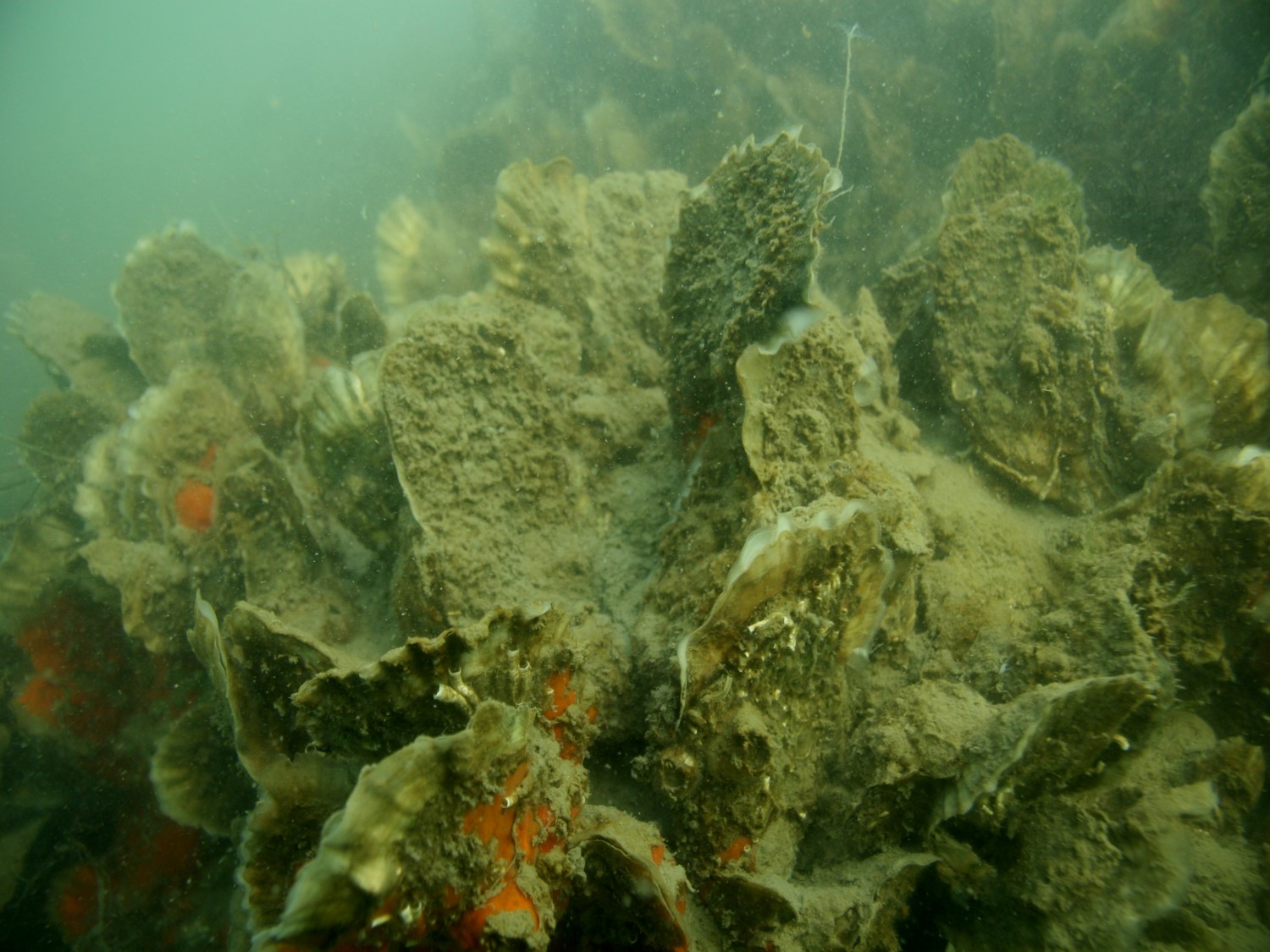WORKING TOGETHER: Communities Collaborate, Engage with Researchers
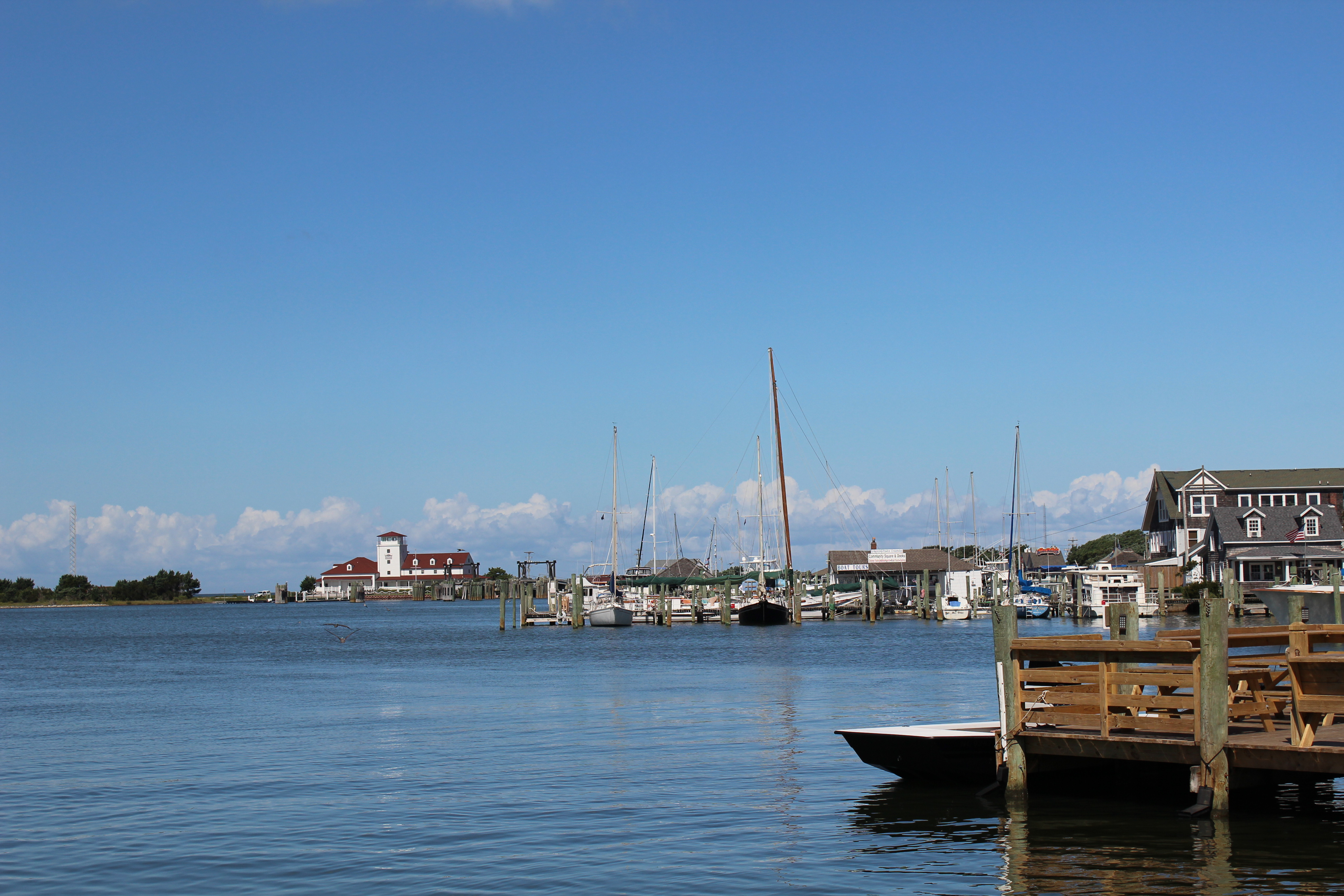
Inspiration comes in many forms: a vibrant cultural festival, getting a bird’s-eye view of the coast, fighting an invasion of the living dead.
These are among the unique experiences galvanizing five new projects receiving funding from the N.C. Community Collaborative Research Grant program. In its second year, the program leverages support from the William R. Kenan Jr. Institute for Engineering, Technology and Science at North Carolina State University with funding from North Carolina Sea Grant.
“Our initial round of funding in 2016 proved successful in achieving research and outreach outcomes for local communities, so we were eager to continue supporting new community-based collaborations,” shares Susan White, Sea Grant executive director.
“We are excited about the possibilities these projects present — and the enduring value and impact that will result as we work together to address issues and opportunities advancing the economic and social well-being of our state,” adds Raj Narayan, associate director of the Kenan Institute. “The newly selected projects will continue to build on Sea Grant’s vision and leadership for community engagement and empowerment.”
John Fear, deputy director of Sea Grant, also notes the communities’ involvement as a program strength. “The selected projects strongly adhere to the spirit and intent of the original mission, with scientists and local experts working together as a team.”
That emphasis on collaboration appeals to the teams as well. “When you have that partner in the community, you get research that is really meaningful and addresses a problem that needs to be solved,” says Whitney Knollenberg, a lead investigator on one of the new projects. “It is not research just for the sake of research.”
A Visual & Oral History Project
Meal-Ready Seafood
Investigating Parasitic Invasions
Sustainable Tourism on Ocracoke Island
New Tech in Crabbing
RISING: A VISUAL AND ORAL HISTORY PERSPECTIVE OF CLIMATE-RELATED CHANGE ON NORTH CAROLINA’S INNER AND OUTER BANKS
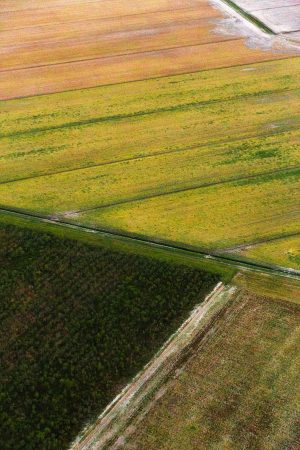
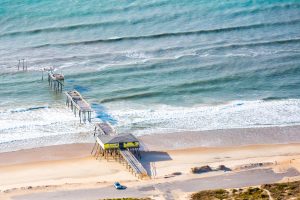
Baxter Miller of Stancil, Miller, & Co., with Barbara Garrity- Blake of Duke Marine Lab, Christine Avenarius of East Carolina University, Karen Willis Amspacher of the Core Sound Waterfowl Museum and Heritage Center, Alton Ballance of the N.C. Center for the Advancement of Teaching, Ben Cahoon of Cahoon & Kasten Architects and the UNC Coastal Studies Foundation, Stan Riggs of East Carolina University, Ryan Stancil of Bit & Grain, Susan West of Coastal Voices, and Jessica Whitehead of North Carolina Sea Grant.
Living at the water’s edge, coastal North Carolinians are the gatekeepers of stories about coastal change and community resilience. Team leader Baxter Miller will combine coastal residents’ insights on the past and perceptions of the future with modern fine art photography. Her goal is to create a new focal point for starting conversations about the increasing threats from climate change.
“The stories told by those who live, work, worship, celebrate, grieve and experience life on our coast often transcend political discourse,” Miller explains. “We want to bring the stories out from behind the data, numbers and science and bring these narratives to life in a way that communicates the threats and the seriousness of these issues.”
Inspiration for the project came from a helicopter tour that offered Miller a new perspective on the places she knew intimately from a childhood on the coast. “Rising above the surface to see this tiny spit of land, I gained a whole new apprecia- tion for the isolation and dynamic fragility of our barrier island system, as well as the resilience of its people.”
Studying those photographs afterward, Miller and fellow team member Ryan Stancil “had a lightbulb hit us both at the same time: We need to explore this with oral history.” They recruited a number of well-known and respected community partners to join them, along with an expert on the science of climate change and community planning, Sea Grant’s Jessica Whitehead.
“I’ve given a lot of scientific presentations, but people always really want to know what climate change will do to their backyard,” Whitehead says. “It’s hard to connect with a line on a graph. But what your neighbor sees, and what it means for her life and livelihood, is a whole other story.”
The partners plan to identify a diverse set of stakeholders for a series of oral history interviews that will be analyzed and synthesized alongside aerial photographs into a traveling exhibit. Stops will include locations on the coast, as well as in eastern North Carolina and in the Triangle. People also can follow along with the project via Facebook.
Ensuring the research had a practical, outreach component was really important to the design of this project. “People, including planners and community managers, don’t necessarily take these things seriously until there’s a perceived immediate threat. Our hope is to heighten awareness so planning occurs sooner rather than later,” Miller says.
IDENTIFYING THE CRITERIA CONSUMERS USE TO SELECT VALUE-ADDED SEAFOOD
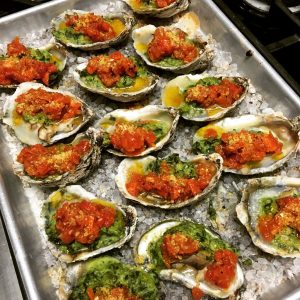
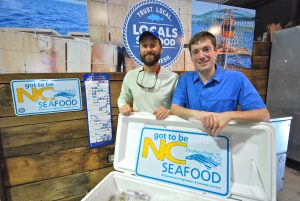
Ryan Speckman and Lin Peterson of Locals Seafood, with Tom Armstrong of Vinnie‘s Steakhouse and Tavern, and Barry Nash of North Carolina Sea Grant
Would you be more willing to try local seafood at home if it required little time or skills in the kitchen? That’s what the owners of Locals Seafood hope to find out by testing and developing ready-to-cook and ready- to-eat products like marinated fillets, dips and meal kits.
“We want to figure out how to get more local seafood on people’s plates,” explains co-owner Ryan Speckman, who describes Locals as an inland fish house. “Our core belief is in helping North Carolina’s seafood industry and this could be a way of providing new opportunities for expanding local markets.”
As evidenced by the rise of pre-packaged foods and meal-kit businesses, many Americans are looking for fresh, healthy options that fit with busy lifestyles. “Nearly two-thirds of consumers believe protein aids weight loss and one-third believe it boosts metabolism. Marine species tend to be high in protein, low in fat and contain heart- healthy omega-3s,” says team member Barry Nash, Sea Grant’s seafood technology and marketing specialist.
While convenience products aren’t necessarily unique, this team will explore them from a new angle by focusing on less- known species caught by North Carolina commercial fishermen.
“We hope that adding convenience will increase the likelihood someone is willing to try something they have never heard of before, like cape shark or amberjack,” Speckman notes. He adds that featuring underutilized fish also could help keep the final price points reasonable while still increasing what the fishermen get paid at the dock.
“Product development is time- consuming and costly, and processors have limited capital. Sea Grant helps processors develop and safely manufacture healthy, transportable meals made with local seafood,” Nash explains.
He will lead focus groups and the distribution of a survey to learn consumers’ preferences and expectations for taste, nutrition, convenience and price. Then, the team will give products developed by Chef Tom Armstrong of Vinnie’s Steakhouse in Raleigh to individuals from the focus groups to try at home.
They hope initially to present their findings at local conferences. The next step will be looking for ways to produce these food items on a larger scale.
“But first we need to develop the markets for these species and products. It’s an opportunity to think outside the box and work together to come up with solutions,” Speckman says.
INVESTIGATING BIOLOGICAL INVASIONS IN N.C. COASTS AND ESTUARIES: FROM A TO ZOMBIE
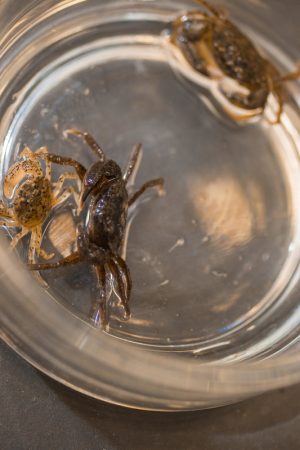
crabs into caring for the invader’s young. Photo by April Blakeslee.
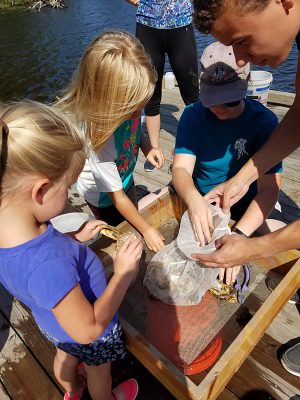
April M.H. Blakeslee of East Carolina University, with Tom Stroud and Russ Chesson of the North Carolina Estuarium, and Kayla Clark of East Carolina
An invasion of the body snatchers is happening now in North Carolina’s waters. Though not exactly the zombie apocalypse, this biological invasion could directly affect ecosystem services we care about, explains marine ecologist April Blakeslee.
She studies Loxothylacus panopaei, a parasitic barnacle that infects native N.C. mud crabs. Native to the Gulf of Mexico, the parasitic barnacle first arrived in the mid-Atlantic in the 1960s and has spread prolifically, sometimes infecting 90 percent of the local mud crabs.
“When the barnacle finds a mud crab, it hijacks the crab’s internal physiology,” Blakeslee explains. “They fool the crab into thinking they are caring for their young when really it’s a sac-full of barnacle babies.”
However, the mud crabs may be able to escape this fate by retreating to areas of lower salinity, such as estuaries, where the barnacles cannot survive. The research team is studying multiple North Carolina estuary sites, looking for parasites and tracking other organisms that live alongside the crabs. Volunteers and students are helping with the sampling.
The data even are available at the N.C. Estuarium in Washington.
The barnacle is just one of many invasive species wreaking havoc in coastal and estuarine ecosystems. Blakeslee and Kayla Clark, an art student at East Carolina University, developed a new exhibit featuring the crab “zombies” and other unwelcome invaders. It launched at the Estuarium days before Halloween.
The interactive display, designed by Clark, focuses on biological invaders in North Carolina, specifically those that thrive in aquatic habitats. Live crabs — healthy and infected — are on display, along with the field data, photos and videos. She wants to make the exhibit appeal to young and old.
“Our goal is to provide outreach and education about invasive species to local audiences, notably children visiting the Estuarium. Visitors also will learn how they can prevent the spread of invaders by not releasing unwanted pets into area waterways, cleaning boats of attached algae, plants or animals, cleaning boots, etc.,” Blakeslee wrote in a Coastwatch Currents blog post for the exhibit’s opening.
“In other words, every person can make a difference in conservation-related efforts,” she adds.
Clark had those audiences in mind, as well. “Melding art and science is a mutually beneficial relationship,” she says.
“Artists, specifically graphic designers like myself, are trained to display information so it is consciously and subconsciously instantly digestible. This can be highly valuable in conveying scientific results to the public.”
IDENTIFYING COMMUNITY CAPITALS FOR A SUSTAINABLE TOURISM WORKFORCE ON OCRACOKE ISLAND
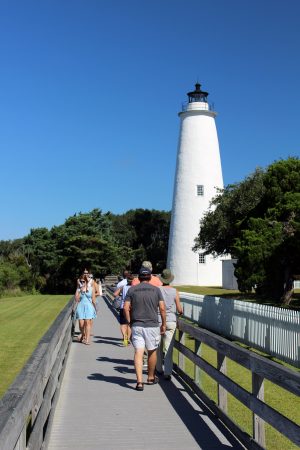
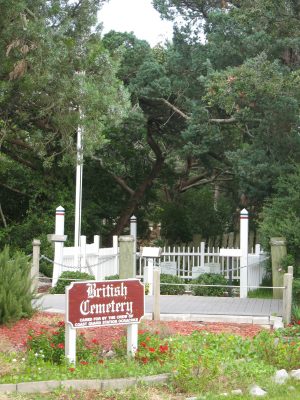
Whitney Knollenberg of North Carolina State University, with David Tweedie of Ocracoke Alive!, David Griffith of East Carolina University, Barbara Garrity-Blake of Duke University Marine Lab, and Jane Harrison of North Carolina Sea Grant
Ocracoke Island is a special place, with a close-knit feel that appeals to visitors and residents alike. Researcher Whitney Knollenberg wants to help keep that magic alive by helping the community understand what resources it needs to build, maintain and sustain its tourism workforce.
“Ocracoke is isolated. It takes an hour ferry ride to get there. People are not going to commute there. Even with a well-paying seasonal job, buying a house and supporting a family there is really hard,” explains Knollenberg, an expert on tourism.
Knollenberg approached David Tweedie of Ocracoke Alive! with the project idea at the Festival Latino de Ocracoke, a celebration of the many Hispanic families who call the island home — and who play an important role in the tourism industry.
“They already know there are challenges, especially with housing. I’m hoping this project will reveal what’s working, what is attractive about living and working in Ocracoke — but also some of the things that can be improved.”
Team members, including Sea Grant coastal economist Jane Harrison, will conduct interviews with employers and host bilingual focus groups with employees. Feedback will be used to determine the community’s strengths when it comes to supporting tourism, as well as areas for future investment.
The team will present findings at a community workshop, with hopes of identifying priority actions for the next five years. Knollenberg anticipates that they’ll need to be creative to address community challenges. “I can’t put Ocracoke any closer to the mainland or create more land,” she says.
In many ways, she adds, “it’s a prime place to do sustainable workforce research. But it’s also a challenging place to do it. In the end, though, it will be helpful for every person on the island to have a more sustainable, stable tourism workforce.”
COMMERCIALIZATION OF LOW-CALCIUM BLUE CRAB SHEDDING TECHNOLOGY
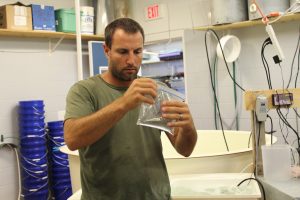
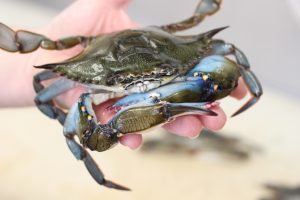
David Cerino of Carteret Community College, with Adam Tyler of Marshallberg, N.C., Thomas C. McArthur III of the North Carolina State University Marine Aquaculture Research Center, and Chuck Weirich of North Carolina Sea Grant
Like new parents, soft-shell crab pro- ducers don’t get a lot of sleep during the molting season. However, new technologies could help them reclaim their nights by extending the time the crabs stay soft.
During the spring and early summer in North Carolina, blue crabs approaching their molt are collected from coastal waters and placed in crab-shedding systems consisting of a series of shallow tanks or trays through which water flows or recirculates. The tanks must be monitored every two to three hours for harvesting before the molted crabs begin to harden again.
“Extending the time crabs stay soft could really help producers, especially those with limited staff and other obligations, such as other commercial fishing operations,” says David Cerino, who heads the aquaculture department at Carteret Community College.
Cerino leads a team in developing water-treatment processes that could give commercial producers using recirculating systems more flexibility in harvesting soft- shell crabs. The project is based on previous research funded by a Sea Grant minigrant that found reducing calcium in shedding systems increases the window for harvesting up to 24 hours.
“We can take processes similar to those municipal water treatment systems use to soften water to remove calcium carbonate and other hardening substances,” Cerino explains.
Lab tests will identify the most consistent and cost-effective water- treatment process before two commercial producers implement the low-calcium recirculating systems. The team then will monitor the systems’ overall water quality, as well as crab survival and time available for harvesting.
“This research will allow us to develop a step-by-step protocol and estimate the cost of implementing low-calcium shedding systems on a commercial scale,” states Chuck Weirich, Sea Grant marine aquaculture specialist and a member of the project team. “Then, we can transfer this technology to other producers in the state.”
This could help improve output of the soft-shell industry that already generates over $2 million annually. “Marine aquaculture offers great opportunities for economic development on the coast. Advances such as this benefit not only producers but also consumers who love seafood,” Weirich adds.
##
- Categories:
